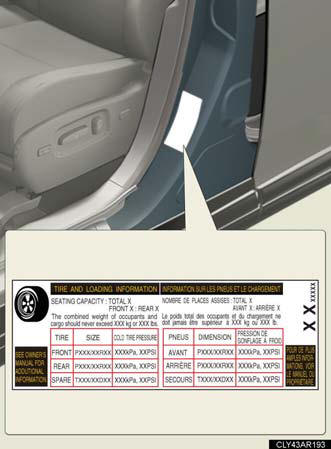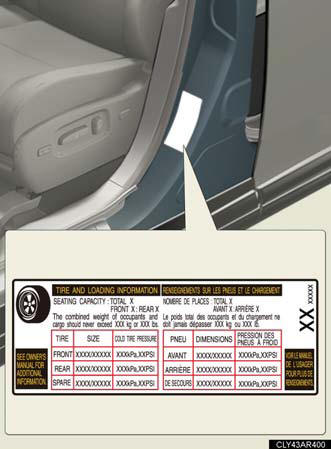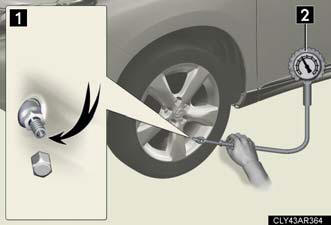Tire inflation pressure
Tire inflation pressure
The recommended cold tire inflation pressure and tire size is displayed on the tire and loading information label.
- Type A

- Type B

Inspection and adjustment procedure

1. Tire valve.
2.Tire pressure gauge.
1. Remove the tire valve cap.
2. Press the tip of the tire pressure gauge onto the tire valve.
3. Read the pressure using the gauge graduations.
4. If the tire inflation pressure is not at the recommended level, adjust the pressure.
If you add too much air, press the center of the valve to deflate.
5. After completing the tire inflation pressure measurement and adjustment, apply soapy water to the valve and check for leakage.
6. Put the tire valve cap back on.
Tire inflation pressure check interval
You should check tire inflation pressure every two weeks, or at least once a month.
Do not forget to check the spare.
Effects of incorrect tire inflation pressure
Driving with incorrect tire inflation pressure may result in the following: Reduced fuel efficiency.
Reduced driving comfort and tire life.
Reduced safety.
Damage to the drive train.
If a tire needs frequent inflating, have it checked by your Lexus dealer.
Instructions for checking tire pressure
When checking tire inflation pressure, observe the following: Check only when the tires are cold.
If your vehicle has been parked for at least 3 hours or has not been driven for
more than 1 mile or 1.5 km, you will get an accurate cold tire inflation
pressure
reading.
Always use a tire pressure gauge.
The appearance of the tire can be misleading. In addition, tire inflation
pressure
that is even just a few pounds off can degrade ride and handling.
Do not reduce tire inflation pressure after driving. It is normal for tire
inflation
pressure to be higher after driving.
Never exceed the vehicle capacity weight.
Passengers and luggage weight should be placed so that the vehicle is balanced.
CAUTION:
Proper inflation is critical to save tire performance
Keep your tires properly inflated. Otherwise, the following conditions may occur
and result in an accident causing death or serious injury:
Excessive wear.
Uneven wear.
Poor handling.
Possibility of blowouts resulting from overheated tires.
Poor sealing of the tire bead.
Wheel deformation and/or tire separation.
A greater possibility of tire damage from road hazards.
NOTICE:
When inspecting and adjusting tire inflation pressure
Be sure to put the tire valve caps back on.
Without the valve caps, dirt or moisture could get into the valve and cause air
leakage,
which could result in an accident. If the caps are lost, replace them as soon as
possible.
See also:
Pricing Notes
The Manufacturer's Suggested Retail Prices (MSRP) on these mid-size sport
sedans reflect their impressive content and capabilities while keeping them
competitive and in line with offerings from th ...
If a warning message is displayed
If a warning is shown on the multi-information display, stay calm and
perform
the following actions:
1. Master warning light.
The master warning light also
comes on or flashes in order to
ind ...
GX in the Market
A decade ago, the GX was unique. Now every luxury brand has a three-row
crossover. Most are excellent machines, and almost all can be had for prices
similar to the GX. When you factor in all the G ...
